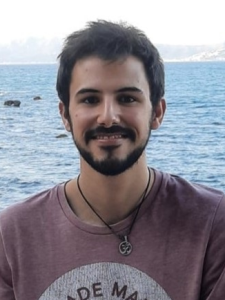 Robert Cardona Aguilar defended his PhD thesis “The geometry and topology of steady Euler flows, integrability and singular geometric structures” (pdf), supervised by Professor Eva Miranda, on 26 May 2021 within the UPC doctoral program in Applied Mathematics. Currently, he is a postdoctoral research fellow at UPC and will move to the Université de Strasbourg with a postdoctoral grant of the Laboratoire d’excellence Institut de recherche en mathématiques, interactions et applications, a project of the Centre National de la Recherche Scientifique in France.
Robert Cardona Aguilar defended his PhD thesis “The geometry and topology of steady Euler flows, integrability and singular geometric structures” (pdf), supervised by Professor Eva Miranda, on 26 May 2021 within the UPC doctoral program in Applied Mathematics. Currently, he is a postdoctoral research fellow at UPC and will move to the Université de Strasbourg with a postdoctoral grant of the Laboratoire d’excellence Institut de recherche en mathématiques, interactions et applications, a project of the Centre National de la Recherche Scientifique in France.
Thesis summary
In this thesis, we make a deep investigation of the geometry and dynamics of several objects (singular or not) appearing in nature. The main goal is to study rigidity versus flexibility in the dynamical behavior of the objects considered. In particular, we inspect normal forms, h-principles, classifications, and existence theorems. These concern a series of objects which are either close or far away from what we call “integrable situations” in the sense of Frobenius’ theorem and the existence of first integrals. Such dynamical systems arise in the context of the Euler equations in hydrodynamics, Reeb fields in contact geometry, and Hamiltonian systems in symplectic geometry (and their singular counterparts).
The first chapter establishes results on the universality properties of steady Euler flows, analyzing Reeb fields in contact manifolds and their close allies in the study of Euler flows (Beltrami vector fields). We extend the h-principles from the contact realm to that of Beltrami vector fields. This enables us [8] to consider universality properties, as introduced by Tao, of steady Euler flows by analyzing those of high-dimensional Reeb flows in contact geometry. In the same spirit, we address [9] the construction of steady Euler flows in dimension 3 which simulate a universal Turing machine, using tools coming from symbolic dynamics. In particular, these solutions have undecidable trajectories, unveiling that non-computable phenomena occur in hydrodynamics, answering a question raised by Moore in the 90s. In all these discussions, a key role is played by different classes of vector fields such as geodesible, Beltrami, and Eulerisable fields.
In the second chapter, we set up [1] the study of the relations between such classes in higher odd-dimensions, showing that new phenomena arise as soon as one leaves the realm of three-dimensional manifolds. For these high dimensional Euler flows (or more generally, flows admitting a strongly adapted one-form), we show [3] that they satisfy the periodic orbit conjecture, which was known to be satisfied with the stronger assumption of geodesibility. We also give [2] classification results of steady Euler flows which admit a Morse-Bott first integral using techniques coming from the symplectic world, and study obstructions arising from the ambient topology. This can be understood as an inverse problem to Arnold’s structure theorem for ideal fluids, a question already suggested by Sullivan in 1995.
As other integral objects, we consider in chapters three and four integrable systems [4] appearing in symplectic manifolds and on singular symplectic manifolds. Singularities show up naturally on these phase spaces by considering manifolds with cylindrical ends and studying b-symplectic forms as initiated by GuilleminMiranda-Pires. Other types of singularities are folded structures originally considered by Martinet and then by Cannas da Silva, Guillemin, Woodward for geometrical purposes. Our analysis includes [5] an isotopy classification of folded symplectic surfaces, the existence of action-angle coordinates on folded symplectic manifolds [6], and a correspondence [7] between the recently introduced b-contact forms and Beltrami fields on b-manifolds.
Highlighted publication
References
[1] R. Cardona. Steady Euler flows and Beltrami fields in high dimensions. Ergodic Theory and Dynamical Systems (2020) 1-24. doi:10.1017/etds.2020.124.
[2] R. Cardona. The topology of Bott integrable fluids. Preprint (2020) arXiv: 2006.16880.
[3] R. Cardona. The periodic orbit conjecture for steady Euler flows. Qual. Theory Dyn. Syst. 20, 52 (2021). DOI:10.1007/s12346-021- 00490-w.
[4] R. Cardona, E. Miranda. Integrable systems and closed one forms. Journal of Geometry and Physics 131 (2018), 204-209.
[5] R. Cardona, E. Miranda. On the volume elements of a manifold with transverse zeroes. Regular and Chaotic Dynamics (2019) vol. 24, no. 2, pp. 187-197.
[6] R. Cardona, E. Miranda. Integrable systems on singular symplectic manifolds: From local to global. International Mathematics Research Notices (2021) https://doi.org/10.1093/imrn/rn b253.
[7] R. Cardona, E. Miranda, D. Peralta-Salas. Euler flows and singular geometric structures. Phil. Trans. R. Soc. A. (2019) 377:20190034.
[8] R. Cardona, E. Miranda, D. Peralta-Salas, F. Presas. Universality of Euler flows and flexibility of Reeb embeddings. Preprint (2019) arXiv: 1911.01963.
[9] R. Cardona, E. Miranda, D. Peralta-Salas and F. Presas. Constructing Turing complete Euler flows in dimension 3. Proceedings of the National Academy of Sciences, 118 (2021), DOI: 10.1073/pnas.2026818118.